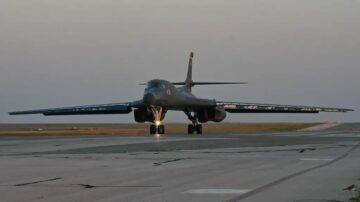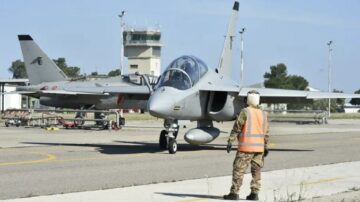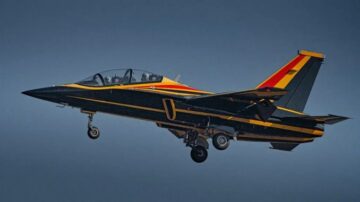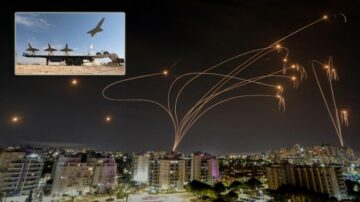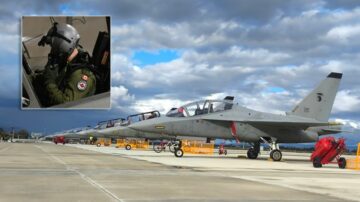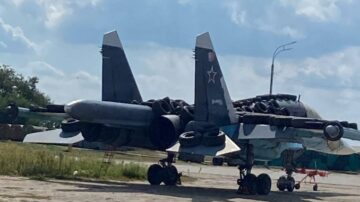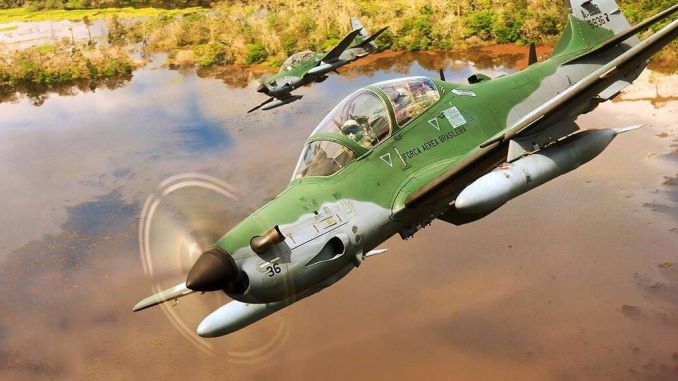
In both cases, upon intercepted, the smugglers opted to crash land their aircraft in an attempt to avoid capture.
The Brazilian Air Force’s A-29 Super Tucanos intercepted two drug planes which were detected as they clandestinely entered Brazilian airspace without a flight plan on April 9 and 10, 2024. In both cases, after being intercepted, the smugglers opted to crash land their aircraft in an attempt to avoid capture, destroying them in the process.
The first aircraft, a Cessna 182, entered Brazilian airspace without a flight plan from Paraguay in the morning of April 9 near Londrina. Two A-29s and an E-99 AEW aircraft were scrambled to investigate and to identify the aircraft, discovering that the bogey’s registration was cloned and its airworthiness certificate was expired.
The aircraft was then ordered to land at Londrina airport, but the pilot instead made a forced landing on a dirt runway near Santa Cruz do Rio Pardo, and the aircraft ended up breaking apart. Brazilian newspapers reported that the aircraft was carrying 565 kg of drugs, while the pilot was captured as he tried to flee the area and was located by a Federal Police helicopter that took part in the intercept mission.
⚠️ *A-29 SUPER TUCANO DA FAB INTERCEPTA AERONAVE CLANDESTINA* ⚠️
Na tarde desta quarta-feira (10/04), a Força Aérea Brasileira (FAB) interceptou, nas proximidades de Rondônia, a aeronave EMB-810D Seneca, matrícula PT-RQY, que ingressou clandestinamente no espaço aéreo… pic.twitter.com/VEBKsswkjb
— Força Aérea Brasileira 🇧🇷 (@fab_oficial) April 10, 2024
A day later, another aircraft, this time a twin engine EMB-810D Seneca, illegally entered Brazilian airspace from Bolivia near Rondônia. After being detected by the ground-based radar network, the aircraft was intercepted by two A-29s, which ordered the pilot to land in Cacoal. The aircraft failed to comply and, following the procedures, the A-29s fired warning shots.
This time the pilot reacted and altered the route to perform a crash landing in an impervious area near Rondolândia. Once on the ground, he set the aircraft on fire and fled the scene before the arrival of the Federal Police. When they arrived on scene, the aircraft was already completely destroyed by the fire, with only the engines, tail and part of the wings surviving.
A Força Aérea Brasileira (FAB) interceptou, na manhã desta terça-feira (09/04), nas proximidades de Londrina (PR) uma aeronave de modelo CESNA-182, de matrícula PT-CPR, que ingressou no espaço aéreo brasileiro oriunda do Paraguai. Duas aeronaves de defesa aérea A-29 Super Tucano,… pic.twitter.com/YH8qIesALX
— Força Aérea Brasileira 🇧🇷 (@fab_oficial) April 9, 2024
Brazil employs the Super Tucano in multiple roles, including in the air defense role, as part of the Integrated Border Protection Program, when slow movers are involved. Similar episodes happen rather frequently, with the last one reported by the FAB in January. In 2021 the A-29s shot down an aircraft carrying 265 kg of drugs after it continued to not comply with the instructions, even after warning shots were fired.
Two weeks ago, a similar episode was reported in Venezuela. In fact, on March 29, the Venezuelan Air Force reported that an aircraft violated the national airspace and, after being intercepted by F-16s, it was declared hostile and shot down with the Viper’s M61 20mm cannon. No details have been released about the intercept and the identity of the aircraft.
🛑 #IMPORTANTE || #FANB neutraliza aeronave, la cual fue declarada “HOSTIL”. Por no contar con plan de vuelo ni autorización por las instituciones de tránsito aéreo para operar en la zona.#IntegrarEsVencer pic.twitter.com/xnOKrFGDh6
— Cuenta Oficial de la Aviación Militar Bolivariana (@AMB_FANB) March 29, 2024
H/T to @juanmab for the heads-up
- SEO Powered Content & PR Distribution. Get Amplified Today.
- PlatoData.Network Vertical Generative Ai. Empower Yourself. Access Here.
- PlatoAiStream. Web3 Intelligence. Knowledge Amplified. Access Here.
- PlatoESG. Carbon, CleanTech, Energy, Environment, Solar, Waste Management. Access Here.
- PlatoHealth. Biotech and Clinical Trials Intelligence. Access Here.
- Source: https://theaviationist.com/2024/04/12/brazilian-a-29-super-tucanos-interceptions/?utm_source=rss&utm_medium=rss&utm_campaign=brazilian-a-29-super-tucanos-interceptions
- :is
- :not
- $UP
- 10
- 125
- 2021
- 2024
- 29
- 9
- a
- About
- Achieve
- Aerospace
- aerospace engineering
- After
- ago
- AIR
- Air Force
- aircraft
- airport
- airspace
- already
- also
- altered
- among
- an
- and
- Another
- apart
- applied
- April
- ARE
- AREA
- areas
- arrival
- arrived
- AS
- At
- attempt
- avatar
- avoid
- based
- been
- before
- being
- border
- both
- Brazil
- Brazilian
- Breaking
- but
- by
- capture
- captured
- carrying
- cases
- certificate
- completely
- comply
- conflicts
- continued
- contributor
- country
- Crash
- Current
- DA
- day
- de
- declared
- Defense
- Degree
- destroyed
- details
- detected
- dirt
- discovering
- do
- down
- drug
- Drugs
- Electronic
- employs
- ended
- Engine
- Engineering
- Engines
- entered
- episode
- Episodes
- Even
- expertise
- fact
- Failed
- Federal
- federal police
- Fire
- fired
- First
- flight
- following
- For
- Force
- forced
- freelance
- frequently
- from
- graduate
- Ground
- happen
- Have
- he
- helicopter
- his
- hostile
- HTTPS
- identify
- Identity
- illegally
- in
- Including
- instead
- instructions
- integrated
- investigate
- involved
- IT
- Italy
- ITS
- January
- journalist
- jpg
- la
- Land
- landing
- LAS
- Last
- later
- located
- made
- March
- master
- Military
- Mission
- morning
- Movers
- multiple
- nas
- National
- Near
- network
- Newspapers
- no
- of
- on
- once
- ONE
- only
- Operations
- osint
- PARA
- Paraguay
- part
- perform
- photo
- pilot
- plan
- Planes
- plato
- Plato Data Intelligence
- PlatoData
- Police
- POR
- pr
- procedures
- process
- Program
- protection
- radar
- rather
- reacted
- Registration
- released
- Reported
- Role
- roles
- Route
- runway
- s
- Santa
- scene
- set
- shot
- shots
- similar
- slow
- Studying
- Super
- techniques
- that
- The
- The Area
- the world
- their
- Them
- then
- they
- this
- time
- to
- took
- tried
- trying
- twin
- two
- upon
- Venezuela
- violated
- warning
- was
- Weeks
- were
- when
- which
- while
- wings
- with
- without
- world
- zephyrnet


